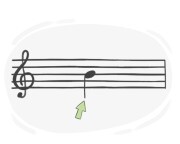

온음표
금관악기 섹션은 온음표를 유지하며 오케스트라의 질감에 풍요로움을 더했습니다.

조
노래의 멜로디는 키의 토닉 음을 중심으로 하여 안정감을 제공했습니다.

내추럴
피아니스트는 특정 음표의 음높이를 명확히 하기 위해 악보를 내추럴로 신중하게 표시했습니다.

옥타브
그 노래의 브릿지는 리드 보컬을 위한 도전적인 옥타브 점프를 포함했습니다.

화음
그는 한 코드에서 다른 코드로 부드럽게 바꾸는 연습을 했습니다.

2분 음표
악보에서 작곡가는 2분 음표를 빈 타원형 모양으로 표시했습니다.

4분음표
그녀는 4분 음표를 안정된 박자로 연주하며 공연 내내 템포를 유지했습니다.

토닉
작곡가는 작품 전체에 걸쳐 반복되는 모티프로 토닉을 사용했습니다.

마디 줄
마디 줄은 음악가들이 리듬을 따라가는 데 도움이 되었습니다.

타블라처
초보 기타리스트로서, 그녀는 타블라처가 표준 악보보다 이해하기 더 쉬운 것을 발견했습니다.

팔분음표
그녀는 리듬의 명확성을 보장하기 위해 각 8분 음표를 정확하게 세고 연주하는 연습을 했습니다.

16분 음표
그는 리듬 일관성을 보장하기 위해 메트로놈 같은 정확도로 16분 음표를 연주하는 연습을 했습니다.

삼십이분음표
그녀는 32분 음표의 구간을 부지런히 연습하며 점차 속도와 정확도를 높였습니다.

육십사분음표
지휘자는 박자를 균등하게 세분화하는 것의 중요성을 강조하며, 각 육십사분음표 그룹을 정확하게 세었습니다.

빔
그녀는 음악 이론 수업에서빔을 그리는 방법을 배웠습니다.

슬러
작곡가는 음악의 구절과 발음을 나타내기 위해 악보에 슬러를 표시했습니다.

사분음
바이올린에서 쿼터 톤을 연주하는 법을 배우려면 정확한 손가락 배치와 통제가 필요했습니다.

변화표
그 곡은 반음계적 멜로디를 만들기 위해 자주 임시표를 사용했습니다.

아르페지오
기타 솔로 동안, 뮤지션은 빠른 아르페지오를 숙련적으로 실행하여 공연에 역동적이고 표현력 있는 요소를 추가했습니다.

트릴
바이올린 솔로의 트릴은 연주자의 기술적 능력과 정확성을 보여주었습니다.

음표 가치
각 음표 값은, 온음표, 반음표, 4분음표 또는 8분음표이든, 음악 작품 내에서 특정한 지속 시간을 나타냅니다.












































